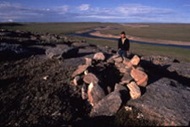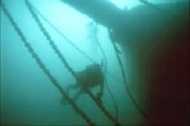Archaeology in National Parks of Canada, National Park Reserves of Canada, National Marine Conservation Areas of Canada and National Marine Conservation Area Reserves of Canada
The CRM Policy also applies to archaeological resources in National Parks, National Park Reserves, National Marine Conservation Areas and National Marine Conservation Area Reserves. In this context, the Parks Canada Agency applies the principles of value, public benefit, understanding, respect and integrity to the management of its archaeological resources.
Direction for managing archaeological resources is addressed in a management plan. Management plans are designed to reflect relevant legislation, policies and formal agreements, and to establish an approach for meeting the objectives of ecological and commemorative integrity and ecological sustainability where applicable.
Within a management plan, a zoning system can be an effective option to protect archaeological resources within a national park or national marine conservation area. The zoning system in National Parks “...is an integrated approach by which land and water areas are classified according to ecosystem and cultural resource protection requirements, and their capability and suitability to provide opportunities for visitor experiences”6. Application of the five zoning categories, ranging from Special Preservation (Zone 1) to Park Services (Zone 5), is based on park objectives, analyses of the natural and cultural resources of the park, and visitor use patterns.
In some cases, environmentally or culturally sensitive areas or sites may warrant special management but do not fit the zoning designation. Management plans will include the guidelines necessary for protecting and using such areas or sites7. It is also possible to make regulations to protect “cultural, historical and archaeological resources” in national marine conservation areas and national parks when management objectives require them8.
Another mechanism to ensure the protection of archaeological resources is through environmental impact assessment reviews. The Canadian Environmental Assessment Act (CEAA) does not apply to all situations, however, when CEAA does not apply, there may be other environmental assessment mechanisms available: Strategic Environmental Assessment, environmental assessment through Parks Canada policy or through separate environmental regimes in specific areas (e.g. land claim agreements). The procedure for applying CEAA is discussed in section 5 of this document.
Archaeologists’ recommendations for managing archaeological resources are of prime importance and can be used by managers in their overall resource assessment and management of a heritage area or a site administered by Parks Canada. Archaeological research reports should include, but are not limited to information in the form of preliminary assessments of the value and significance of resources, assessments of threats to the integrity of resources and prescriptions for monitoring programs.

Subterranean Food Cache, Tuktut Nogait National Park of Canada
© Parks Canada
Leslie Leong / 1998

BarqueArabia, Fathom Five National Park of Canada
© Parks Canada
6 Guiding Principles and Operational Policies, 1994, p. 30.
7 Idem, 1994, p. 31.
8 Canada National Marine Conservation Areas Act, 2002, C. 18 , Canada National Parks Act, 2000, C. 32
Related links
- Introduction
- Objective
- Archaeology in National Historic Sites of Canada
- Responsibility for Archaeological Resources in Areas under...
- Legal Obligations, Policy Directives, and Administrative...
- Principles of Archaeological Resource Management
- APPENDIX 1 - Definitions
- APPENDIX 2 - References
- APPENDIX 3 - A Selection of Value Indicators for Level II...
- APPENDIX 4 - Parks Canada Offices and Contacts
- APPENDIX 5 - Provincial, Territorial and Federal, Contacts...
- APPENDIX 6- Other Archaeological Principles and...
- Date modified :